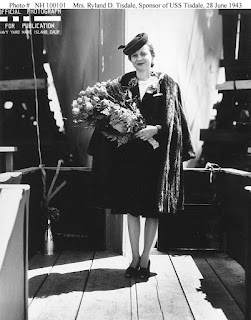Figure 1: Ship's Sponsor of USS Tisdale (DE-33), Mrs. Ryland D. Tisdale, on the christening platform just before Tisdale was launched at the Mare Island Navy Yard, California, 28 June 1943. Official US Navy Photograph, from the collections of the Naval Historical Center. Click on photograph for larger image.
Figure 2: Sponsor's party at USS Tisdale’s (DE-33) launching, Mare Island Navy Yard, California, 28 June 1943. Those present are (from left to right): Mrs. Wilhelm L. Friedell; Rear Admiral Wilhelm L. Friedell, USN; Mrs. Park, Matron of Honor; Captain Francis W. Scanland, USN; Mrs. Ryland D. Tisdale, Sponsor; Captain William E. Malloy, USN; and Mrs. Lannis A. Parker. Official US Navy Photograph, from the collections of the Naval Historical Center. Click on photograph for larger image.
Figure 3: Mrs.
Ryland D. Tisdale christens USS Tisdale
(DE-33) at the Mare Island Navy Yard, California, on 28 June 1943. US Navy Photograph DE-33-4664-43. Click on photograph for larger
image.
Figure 4: USS Tisdale (DE-33) is at the end of the ways during her launching
at the Mare Island Navy Yard on 28 June 1943. US Navy Photo DE-33-4662-43. Click on photograph for larger image.
Figure 5: USS Tisdale (DE-33) photographed during World War II, probably upon her return to the United States in August 1945 as she appears to be flying a long "homeward bound" pennant. Courtesy of Donald M. McPherson, 1974. US Naval Historical Center Photograph. Click on photograph for larger image.
Named after Commander Ryland Dillard Tisdale (1894-1942), a
US Navy hero who was killed in the Philippines during the early months of World
War II, the 1,140-ton USS Tisdale
(DE-33) was an Evarts class destroyer
escort that was built by the Mare Island Navy Yard at Vallejo, California, and was
commissioned on 11 October 1943. The ship was approximately 289 feet long and
35 feet wide, had a top speed of 21 knots, and had a crew of 156 officers and men.
Tisdale was armed with three 3-inch
guns, four 1.1-inch guns, nine 20-mm guns, and depth charges.
After her shakedown cruise, Tisdale escorted shipping in the central and south Pacific during
the first five months of 1944. In June 1944, Tisdale screened the floating reserve during the invasion of
Saipan, helping to defend American transports during the ensuing Battle of the
Philippine Sea. Later that month, as well as in July, Tisdale used her guns for bombardment and illumination missions off
the coasts of Saipan and Tinian. For the rest of 1944 and into 1945, Tisdale was assigned to escort duties in
the central Pacific. On 3 February 1945, Tisdale
attacked a sonar contact and although she received no official credit for it,
it was determined that the destroyer escort probably sank a Japanese submarine.
From late March to mid-June 1945, Tisdale participated in the Okinawa campaign, screening escort
aircraft carriers and supply convoys as well as serving as a radar picket ship.
Radar picket ships were placed away from the main invasion force and were used
to warn of impending air attacks. Fortunately, American combat air patrols over
the invasion fleet either shot down or chased away the enemy aircraft that
approached Tisdale. But the ship served
its purpose by directing American aircraft towards the approaching Japanese
planes before they could do any serious damage to the invasion force.
Tisdale
returned to the United States for an overhaul and arrived at San Francisco,
California, on 1 August 1945. Four days later, she steamed to Portland, Oregon.
The Japanese, though, agreed to surrender on 15 August and Tisdale began decommissioning procedures soon after that. The ship
was decommissioned on 17 November 1945 and was sold for scrapping on 2 February
1948. USS Tisdale was one of those
small ships that played a vital, if little known, role during World War II when
the US Navy desperately needed escorts to perform a wide variety of tasks. But
once the war was over, they were no longer needed and were soon forgotten. USS Tisdale earned four battle stars for her
service during World War II and escorted literally hundreds of ships. This was
a fine record for such a small naval vessel.






